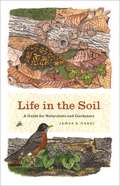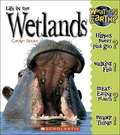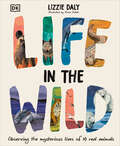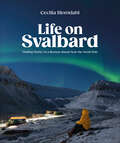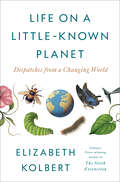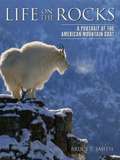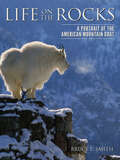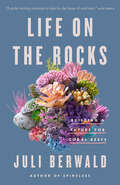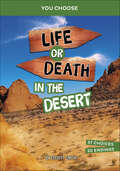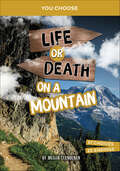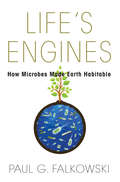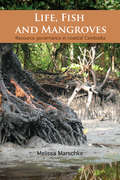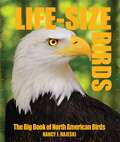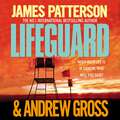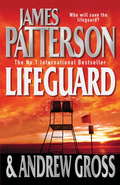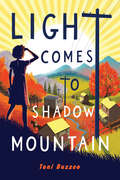- Table View
- List View
Life in the Soil: A Guide for Naturalists and Gardeners
by James B. NardiLeonardo da Vinci once mused that “we know more about the movement of celestial bodies than about the soil underfoot,” an observation that is as apt today as it was five hundred years ago. The biological world under our toes is often unexplored and unappreciated, yet it teems with life. In one square meter of earth, there lives trillions of bacteria, millions of nematodes, hundreds of thousands of mites, thousands of insects and worms, and hundreds of snails and slugs. But because of their location and size, many of these creatures are as unfamiliar and bizarre to us as anything found at the bottom of the ocean. Lavishly illustrated with nearly three hundred color illustrations and masterfully-rendered black and white drawings throughout, Life in the Soil invites naturalists and gardeners alike to dig in and discover the diverse community of creatures living in the dirt below us. Biologist and acclaimed natural history artist James B. Nardibegins with an introduction to soil ecosystems, revealing the unseen labors of underground organisms maintaining the rich fertility of the earth as they recycle nutrients between the living and mineral worlds. He then introduces readers to a dazzling array of creatures: wolf spiders with glowing red eyes, snails with 120 rows of teeth, and 10,000-year-old fungi, among others. Organized by taxon, Life in the Soil covers everything from slime molds and roundworms to woodlice and dung beetles, as well as vertebrates from salamanders to shrews. The book ultimately explores the crucial role of soil ecosystems in conserving the worlds above and below ground. A unique and illustrative introduction to the many unheralded creatures that inhabit our soils and shape our environment aboveground, Life in the Soil will inform and enrich the naturalist in all of us.
Life in the Wetlands (What on Earth)
by Carolyn ScraceWetlands are not just muddy swamps or murky bogs! They are packed full of amazing plants and animals. Many of these would die without the food, water, and shelter that wetlands provide. Wetlands can be large or small, hot or cold.
Life in the Wild: Observing the Mysterious Lives of 10 Real Animals
by Lizzie DalyWhat can 10 real-life and uniquely jaw-dropping animal journeys teach us about our world, and the ways in which it is changing?As a filmmaker and scientist, Lizzie Daly tells stories about the natural world and uncovers the hidden secrets of our planet. But despite huge advances in technology, there is still so much we don't know about what species get up to in the wild. However, sometimes—just sometimes—we get a small glimpse into what their lives are like.This book tells the tale of our planet's intriguing wildlife. Through 10 real stories, we follow in the footprints of polar bears, big cats, wolves, and jaguars, and explore oceans with whales, sharks, and seabirds. These tales of migration, mystery, and unique behaviors teach us new and exciting information about animal activity and ecology and give us access to some of the most inhospitable corners of our planet.
Life of Inland Waters: An Elementary Text Book of Fresh-Water Biology For Students
by James G. NeedhamThis work is a textbook of fresh-water life dealing with its forms, its conditions, its fitnesses, its associations, and its economic aspects. The ecologic side of fresh-water biology is emphasized. Due consideration is given to the educational, economic, sanitary, social, civic, and aesthetic aspects of the subject.Limnology in America today is in its infancy. The value of its past achievements is just beginning to be appreciated. The benefits to come from a more intensive study of water life arc just beginning to be disclosed. That there is a widespread interest is already manifest in the large number of biological stations at which limnological work is being done.We recommend this volume as a general introduction to all students and teachers of this subject.
Life on Surtsey: Iceland's Upstart Island (Scientists in the Field Series)
by Loree Griffin BurnsOn November 14, 1963, a volcano fifteen miles off the shore of Iceland exploded under the sea, resulting in a brand-new island. Scientists immediately recognized Surtsey for what it was: an opportunity to observe the way life takes hold. Loree Griffin Burns follows entomologist Erling Ólafsson on a five-day trip to Surtsey, where since 1970 he has studied the arrival and survival of insects and other species. Readers see how demanding conditions on Surtsey can be, what it’s like to eat and work while making the smallest impact possible, and the passion driving these remarkable scientists in one of the world’s most unique fields ever!
Life on Svalbard: Finding Home on a Remote Island Near the North Pole
by Cecilia BlomdahlJoin Cecilia Blomdahl in Longyearbyen, Svalbard, the world’s northernmost town. Located in the Arctic Ocean near the North Pole, Svalbard is a unique archipelago that boasts stunning wintry landscapes, endangered Arctic animals, and awe-inspiring natural phenomena. Since 2015, Cecilia has called this beautiful and remote location home. Along with her partner, Christoffer, and her dog, Grim, she has adjusted to life at the top of the world—where polar bears roam free and northern lights shine bright.With evocative text and spectacular photography, Cecilia shares the joys and challenges of adapting to an inhospitable climate. Her story begins in the darkness of polar night, and the allure of her remote location is revealed gradually as sunlight returns months later. Through personal stories and firsthand advice, Cecilia offers insight for anyone seeking to thrive in unusual living conditions. Whatever your location, Life on Svalbard will give you a deeper understanding of why people choose to live in extreme environments and perhaps help you find the hidden magic of where you live too. <br><b>New York Times Bestseller</b></br>
Life on a Little-Known Planet: Dispatches from a Changing World
by Elizabeth KolbertA landmark collection of Pulitzer Prize winner Elizabeth Kolbert's most important pieces about climate change and the natural world"To be a well-informed citizen of Planet Earth," Rolling Stone has advised, "you need to read Elizabeth Kolbert." From her National Magazine Award-winning series The Climate of Man to her Pulitzer Prize-winning book The Sixth Extinction, Kolbert&’s work has shaped the way we think about the environment in the twenty-first century. Collected in Life on a Little-Known Planet are her most influential and thought-provoking essays.An intrepid reporter and a skillful translator of scientific idees, Kolbert expertly captures the wonders of nature and paints vivid portraits of the researchers and concerned citizens working to preserve them. She takes readers all around the globe, from an island in Denmark that&’s succeeded in going carbon neutral, to a community in Florida that voted to give rights to waterways, to the Greenland ice sheet, which is melting in a way that has implications for everyone. We meet a biologist who believes we can talk to whales, an entomologist racing to find rare caterpillars before they disappear, and a climatologist who&’s considered the "father of global warming," amongst other scientists at the forefront of environmental protection.The threats to our planet that Kolbert has devoted so much of her career to exposing have only grown more serious. Now is the time to deepen our understanding of the world we are in danger of losing.
Life on the Rocks: A Portrait of the American Mountain Goat
by Bruce L. SmithThe American mountain goat is one of the most elusive and least familiar species of hoofed mammals in North America. Confined to the remote and rugged mountains of the western United States and Canada, these extraordinary mountaineers are seldom seen or encountered, even by those who patiently study them. Life on the Rocks offers an intimate portrayal of this remarkable animal through the eyes and lens of field biologist and photographer Bruce Smith. Color photographs and accounts of Smith's personal experiences living in Montana's Selway-Bitterroot Wilderness Area accompany descriptions of the American mountain goat's natural history. Smith explores their treacherous habitat, which spans the perilous cliffs and crags of the Rocky, Cascade, and Coast mountain ranges. The physical and behavioral adaptations of these alpine athletes enable them to survive a host of dangers, including six-month-long winters, scarce food sources, thunderous avalanches, social strife, and predators like wolves, bears, lions, wolverines, and eagles. Smith also details the challenges these animals face as their territory is threatened by expanding motorized access, industrial activities, and a warming climate.<P> Life on the Rocks showcases the elegance and charm of this little-known creature, thriving in some of North America's harshest wilderness. Smith's volume will appeal to wildlife enthusiasts, wildland travelers, and conservationists interested in the future of the American mountain goat.
Life on the Rocks: A Portrait of the American Mountain Goat
by Bruce L. SmithThe American mountain goat is one of the most elusive and least familiar species of hoofed mammals in North America. Confined to the remote and rugged mountains of the western United States and Canada, these extraordinary mountaineers are seldom seen or encountered, even by those who patiently study them. Life on the Rocks offers an intimate portrayal of this remarkable animal through the eyes and lens of field biologist and photographer Bruce Smith. Color photographs and accounts of Smith's personal experiences living in Montana's Selway-Bitterroot Wilderness Area accompany descriptions of the American mountain goat's natural history. Smith explores their treacherous habitat, which spans the perilous cliffs and crags of the Rocky, Cascade, and Coast mountain ranges. The physical and behavioral adaptations of these alpine athletes enable them to survive a host of dangers, including six-month-long winters, scarce food sources, thunderous avalanches, social strife, and predators like wolves, bears, lions, wolverines, and eagles. Smith also details the challenges these animals face as their territory is threatened by expanding motorized access, industrial activities, and a warming climate. Life on the Rocks showcases the elegance and charm of this little-known creature, thriving in some of North America's harshest wilderness. Smith's volume will appeal to wildlife enthusiasts, wildland travelers, and conservationists interested in the future of the American mountain goat. 2014 National Outdoor Book Award winner: Nature & Environment and co-winner: Design and Artistic Merit
Life on the Rocks: Building a Future for Coral Reefs
by Juli BerwaldThe story of the urgent fight to save coral reefs, and why it matters to us allCoral reefs are a microcosm of our planet: extraordinarily diverse, deeply interconnected, and full of wonders. When they&’re thriving, these fairy gardens hidden beneath the ocean&’s surface burst with color and life. They sustain bountiful ecosystems and protect vulnerable coasts. Corals themselves are evolutionary marvels that build elaborate limestone formations from their collective skeletons, broker symbiotic relationships with algae, and manufacture their own fluorescent sunblock. But corals across the planet are in the middle of an unprecedented die-off, beset by warming oceans, pollution, damage by humans, and a devastating pandemic.Juli Berwald fell in love with coral reefs as a marine biology student, entranced by their beauty and complexity. Alarmed by their peril, she traveled the world to discover how to prevent their loss. She met scientists and activists operating in emergency mode, doing everything they can think of to prevent coral reefs from disappearing forever. She was so amazed by the ingenuity of these last-ditch efforts that she joined in rescue missions, unexpected partnerships, and risky experiments, and helped rebuild reefs with rebar and zip ties.Life on the Rocks is an inspiring, lucid, meditative ode to the reefs and the undaunted scientists working to save them against almost impossible odds. As she also attempts to help her daughter in her struggle with mental illness, Berwald explores what it means to keep fighting a battle whose outcome is uncertain. She contemplates the inevitable grief of climate change and the beauty of small victories.
Life or Death in the Desert (You Choose)
by Elliott SmithThe sun beats down on YOU in the dry, barren desert. Somehow, you&’ve found yourself lost there. How will you find water and protect yourself from dangerous animals? And will you be able to get help before it&’s too late? It&’s time to make some difficult choices. With some smart decision making and a little luck, perhaps you&’ll be able to survive being lost in a desert!
Life or Death on a Mountain (You Choose)
by Megan ClendenanYOU are lost in the unforgiving terrain of a mountain. Your survival is hanging by a thread. How will you get down? Will you be able to steer clear of dangerous animals? And will you be able to get help before it&’s too late? It&’s time to make some difficult choices. With some smart decision making and a little luck, perhaps you&’ll be able to survive being lost on a mountain!
Life's Engines: How Microbes Made Earth Habitable
by Paul G. FalkowskiFor almost four billion years, microbes had the primordial oceans all to themselves. The stewards of Earth, these organisms transformed the chemistry of our planet to make it habitable for plants, animals, and us. Life's Engines takes readers deep into the microscopic world to explore how these marvelous creatures made life on Earth possible--and how human life today would cease to exist without them.Paul Falkowski looks "under the hood" of microbes to find the engines of life, the actual working parts that do the biochemical heavy lifting for every living organism on Earth. With insight and humor, he explains how these miniature engines are built--and how they have been appropriated by and assembled like Lego sets within every creature that walks, swims, or flies. Falkowski shows how evolution works to maintain this core machinery of life, and how we and other animals are veritable conglomerations of microbes.A vibrantly entertaining book about the microbes that support our very existence, Life's Engines will inspire wonder about these elegantly complex nanomachines that have driven life since its origin. It also issues a timely warning about the dangers of tinkering with that machinery to make it more "efficient" at meeting the ever-growing demands of humans in the coming century.
Life's Engines: How Microbes Made Earth Habitable (Princeton Science Library #137)
by Paul G. FalkowskiThe marvelous microbes that made life on Earth possible and support our very existenceFor almost four billion years, microbes had the primordial oceans all to themselves. The stewards of Earth, these organisms transformed the chemistry of our planet to make it habitable for plants, animals, and us. Life's Engines takes readers deep into the microscopic world to explore how these marvelous creatures made life on Earth possible—and how human life today would cease to exist without them.Paul Falkowski looks "under the hood" of microbes to find the engines of life, the actual working parts that do the biochemical heavy lifting for every living organism on Earth. With insight and humor, he explains how these miniature engines are built—and how they have been appropriated by and assembled like Lego sets within every creature that walks, swims, or flies. Falkowski shows how evolution works to maintain this core machinery of life, and how we and other animals are veritable conglomerations of microbes.A vibrantly entertaining book about the microbes that support our very existence, Life's Engines will inspire wonder about these elegantly complex nanomachines that have driven life since its origin. It also issues a timely warning about the dangers of tinkering with that machinery to make it more "efficient" at meeting the ever-growing demands of humans in the coming century.
Life, Fish and Mangroves: Resource Governance in Coastal Cambodia (Governance Series)
by Melissa MarschkeIn Life, Fish and Mangroves, Melissa Marschke explores the potential of resource governance, offering a case study of resource-dependent village life. Following six households and one village-based institution in coastal Cambodia over a twelve-year period, Marschke reveals the opportunities and constraints facing villagers and illustrates why local resource management practices remain delicate, even with a sustained effort. She highlights how government and business interests in community-based management and resource exploitation combine to produce a complex, highly uncertain dynamic. With this instructive study, she demonstrates that in spite of a significant effort, spanning many years and engaging many players, resource governance remains fragile and coastal livelihoods in Cambodia remain precarious.
Life-Size Birds: The Big Book of North American Birds
by Nancy J. HajeskiThe biggest book on North American birds this century!John James Audubon would be proud to know that a life-size bird book is alive in the twenty-first century. You won't need Sotheby's auction house to buy this volume, though! Full-size images of beautiful feathered friends offer a detailed look at each North American species, while scaled photographs of larger birds allow you to see the entire animal. Fun facts pepper the pages, and a summary of general information accompanies each avian. Get an up-close, personal look at the world's masters of flight!
Life: A Journey through Science and Politics
by Paul R. EhrlichA renowned scientist and environmental advocate looks back on a life that has straddled the worlds of science and politics “Entirely entertaining.”—Kirkus Reviews Acclaimed as a public scientist and as a spokesperson on pressing environmental and equity issues, delivering his message from the classroom to 60 Minutes, Paul R. Ehrlich reflects on his life, including his love affair with his wife, Anne, his scientific research, his public advocacy, and his concern for global issues. Interweaving the range of his experiences—as an airplane pilot, a desegregationist, a proud parent—Ehrlich’s insights are priceless on pressing issues such as biodiversity loss, overpopulation, depletion of resources, and deterioration of the environment. A lifelong advocate for women’s reproductive rights, Ehrlich also helped to debunk scientific bias associating skin color and intelligence and warned some fifty years ago about a possible pandemic and the likely ecological consequences of a nuclear war. This book is a vital contribution to literature focused on the human predicament, including problems of governance and democracy in the twenty-first century, and insight into the ecological and evolutionary science of our day. It is a must-read for anyone interested in understanding global change, our planet’s wonders, and a scientific approach to the present existential threats to civilization.
LifePlace: Bioregional Thought and Practice
by Robert L. Thayer Jr.This is a passionately written advocacy of bioregionalism, the conviction that people should live, work, play, and consume locally, for the health of the environment and for society. The book is inspirational as well as educational, a combination of philosophy and practical suggestions for implementing bioregionalism in communities.
Lifeblood: Oil, Freedom, and the Forces of Capital (A Quadrant Book)
by Matthew T. HuberIf our oil addiction is so bad for us, why don&’t we kick the habit? Looking beyond the usual culprits—Big Oil, petro-states, and the strategists of empire—Lifeblood finds a deeper and more complex explanation in everyday practices of oil consumption in American culture. Those practices, Matthew T. Huber suggests, have in fact been instrumental in shaping the broader cultural politics of American capitalism.How did gasoline and countless other petroleum products become so central to our notions of the American way of life? Huber traces the answer from the 1930s through the oil shocks of the 1970s to our present predicament, revealing that oil&’s role in defining popular culture extends far beyond material connections between oil, suburbia, and automobility. He shows how oil powered a cultural politics of entrepreneurial life—the very American idea that life itself is a product of individual entrepreneurial capacities. In so doing he uses oil to retell American political history from the triumph of New Deal liberalism to the rise of the New Right, from oil&’s celebration as the lifeblood of postwar capitalism to increasing anxieties over oil addiction.Lifeblood rethinks debates surrounding energy and capitalism, neoliberalism and nature, and the importance of suburbanization in the rightward shift in American politics. Today, Huber tells us, as crises attributable to oil intensify, a populist clamoring for cheap energy has less to do with American excess than with the eroding conditions of life under neoliberalism.
Lifeguard
by James Patterson Andrew GrossThe perfect job. Working for an easy-going boss at his luxurious mansion by the sun-kissed beach, watching beautiful women walk by. The perfect girl. Tess - gorgeous, funny, apparently very rich and crazy for him.The perfect score. Five million up for grabs. And to get his share, all he needs to do is trigger three house alarms to throw the cops off the scent of the real robbery.Could things get any better for Ned Kelly? But things don't go according to plan. And when Tess is brutally murdered and the others involved in the robbery are massacred, Ned is the prime suspect. With danger at every twist and turn, he's running for his life.(P)2012 Headline Digital
Lifeguard: Bookshots
by James Patterson Andrew GrossThe perfect job. Working for an easy-going boss at his luxurious mansion by the sun-kissed beach, watching beautiful women walk by. The perfect girl. Tess - gorgeous, funny, apparently very rich and crazy for him.The perfect score. Five million up for grabs. And to get his share, all he needs to do is trigger three house alarms to throw the cops off the scent of the real robbery.Could things get any better for Ned Kelly? But things don't go according to plan. And when Tess is brutally murdered and the others involved in the robbery are massacred, Ned is the prime suspect. With danger at every twist and turn, he's running for his life.
Lifelines: The Case For River Conservation
by Tim Palmer"In Lifelines, Tim Palmer addresses the fate of our waterways. While proposals for gigantic federal dams are no longer common, and some of the worst pollution has been brought under control, myriad other concerns have appeared -- many of them more subtle and complex than the threats of the past.Palmer examines the alarming condition of rivers in today's world, reports on the success in restoring some of our most polluted streams and in stopping destructive dams, and builds the case for what must be done to avoid the collapse of riparian ecosystems and to reclaim qualities we cannot do without. He documents the needs for a new level of awareness and suggests ways to avert the plunder of our remaining river legacy.Lifelines offers a fresh perspective on: the values of natural rivers current threats to streams and possibilities for reform the continuing challenge of hydropower development water quality, instream flows, and riparian habitat ecosystem management and watershed protection the need for vision, hope, and action
Lifelong Learning for Green Skills and Sustainable Development: Southern European Perspectives
by Nikša Alfirević Jurica Pavičić Tihomir Žiljak Philippe RistordThis edited book analyses the implementation of green transformation policies and the UN Sustainable Development Goals across the European Union, in the context of lifelong learning and educational practices. The contributions examine how green skills became mainstreamed in member states’ education policies, as well as the social, economic and political circumstances contributing to this process. A focus on lifelong learning (from an early age to adulthood) is maintained throughout the volume, and the book will appeal to researchers, students, policy- and decision-makers in education, environmental and social studies.
Lifestyle Sports and Public Policy (Routledge Research in Sport, Culture and Society)
by Daniel Turner Sandro CarnicelliLifestyle Sports and Public Policy is the first book to develop a comprehensive understanding of the interplay between lifestyle sports and the public policy environment which frames and regulates them. Drawing on a wide range of lifestyle sports from across the globe, including parkour, skateboarding, mountain biking and climbing, it identifies the critical issues facing practitioners and policymakers as these sports become increasingly popular. Part I examines public sector bodies that provide lifestyle sports opportunities to the public, either through funding partners or by managing facilities themselves. Part II looks at the use of lifestyle sports to promote policy agendas such as improving public health, while Part III considers the impact of public sector regulatory actions on the lifestyle sports industry. Each part contains case studies which investigate a policy issue from the perspective of a different lifestyle sport, including some sports which have traditionally been under-represented such as rodeo and curling. This book is a valuable resource for anyone with an interest in lifestyle sports, leisure studies, sport tourism, leisure management or sport policy.
Light Comes to Shadow Mountain
by Toni BuzzeoCora Mae Tipton is determined to light up her Appalachian community in this historical fiction novel from an award-winning author and former librarian.It&’s 1937 and the government is pushing to bring electricity to the mountains of southeastern Kentucky. It&’s all Cora can think of; radios with news from around the world, machines that keep food cold, lightbulbs by which to read at night! Cora figures she can help spread the word by starting a school newspaper and convincing her neighbors to support the Rural Electrification Act.But resistance to change isn&’t easy to overcome, especially when it starts at home. Cora&’s mother is a fierce opponent of electrification. She argues that protecting the landscape of the holler—the trees, the streams, the land that provides for their way of life—is their responsibility. But Cora just can&’t let go of wanting more. Lyrical, literary, and deeply heartfelt, this debut novel from an award-winning author-librarian speaks to family, friendship, and loss through the spirited perspective of a girl eager for an electrified existence, but most of all, the light of her mother&’s love and acceptance.Back matter includes an Author&’s Note; further information on the Rural Electrification Act, the herbs and plants of Appalachia, the Pack Horse Library Project, and more; and a &“Quick Questions&” historical trivia section for readers.A Junior Library Guild Gold Standard Selection
